DACF Home → Bureaus & Programs → Maine Natural Areas Program → Ecological Reserves → St. John Ponds
(Printer Friendly Version-44 KB pdf) (Download a free copy of Adobe Acrobat Reader)
St. John Ponds
T4 R17 WELS
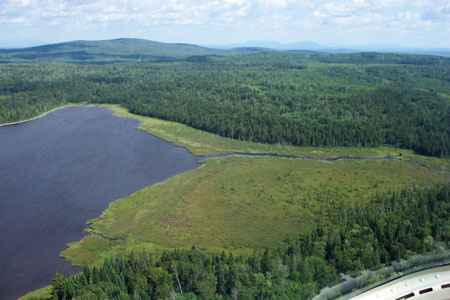
Vital Statistics
- Size: 3,887 acres
- Upland: 3,558 acres
- Wetlands (NWI): 532 acres
- Open Water: 329 acres
- Roads: unimproved-4 miles
- Biophysical Region: St. John Uplands
- BPL Region: West
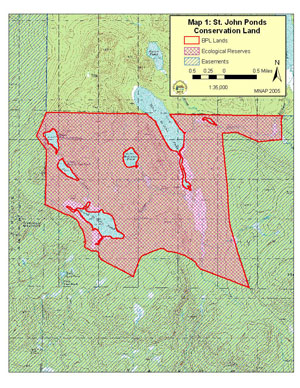
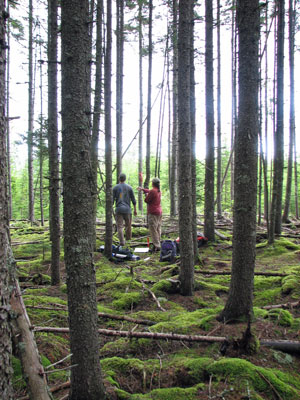
(Download a Printer Friendly Version-335 KB pdf-of this map.)
Exemplary Natural Communities
| Scientific Name | Common Name | State Rank | Global Rank |
|---|---|---|---|
| Streamshore Ecosystem | Streamshore Ecosystem | S5 | GNR |
Rare Plants
| Scientific Name | Common Name | State Rank | Global Rank | State Status |
|---|---|---|---|---|
| Carex rostrata | Blue-leaved Sedge | S2 | G5 | SC |
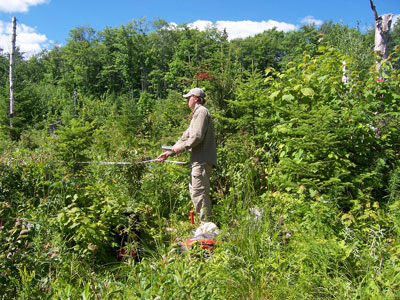
Rare Animals
There are no documented occurrences of rare animals within this Ecoreserve. For more information on rare animals in Maine, visit the Maine Department of Inland Fisheries and Wildlife.
Description
The upper St. John Ponds include First (Lower and Upper), Second, and Third St. John Ponds and Robinson Pond. Collectively, these water bodies form the headwaters of the St. John River. The Ponds are perched at the top of the watershed, with First St. John Pond over 1800 feet in elevation.
Upland forests within the Reserve were heavily harvested in the late 1980s and are now dominated by sapling-stage natural regeneration. A handful of remnant mature pockets exist in riparian areas and along ephemeral streams. In a few small hardwood ravines dominated by sugar maple, several rich-woods "indicator" plants were noted: Braun's holly fern, snakeroot, doll's eyes, ostrich fern, and foam-flower.
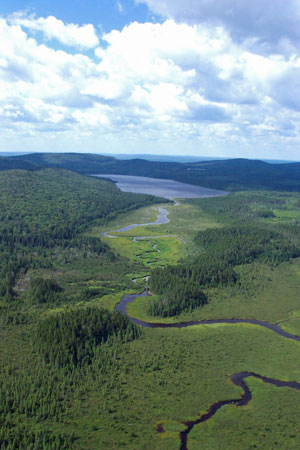
Wetlands associated with the Ponds consist of a narrow forested border, some small fringing Spruce - Larch Forested Bogs, and open wetlands. In one forested bog below Third St. John Pond, the trees are mostly 5-10" dbh and there is evidence of a harvest 40+ years ago. Robinson Pond and Second St. John Pond are ringed by a narrow zone of Northern White Cedar Seepage Forest, with some large trees exceeding 30" in diameter.
Open wetlands within the Reserve are a mix of slightly raised peatlands and somewhat lower, seasonally flooded emergent marshes. Evidence of past and current beaver activity is frequent. Within the open wetlands, the dominant natural community is Sweet-gale Mixed Shrub Fen, characterized by sweet gale (Myrica gale) and leatherleaf (Chamaedaphne calyculata), with other frequently occurring species including the sedges Carex lasiocarpa, Eriophorum virginicum, and Carex stricta. Closer to the edge of the inlet streams, the wetlands grade into Leatherleaf Boggy Fens, with leatherleaf, buckbean (Menyanthes trifoliata), large cranberry (Vaccinium macrocarpon), pitcher plant (Sarracenia purpurea), bog rosemary (Andromeda glaucophylla) and the sedges Carex oligosperma, Carex limosa, and Carex lasiocarpa. The rare sedge Carex rostrata was found on the inlet streams to Second, Third, and Robinson Ponds as well as in a small roadside wetland. Towards the interior of the peatlands, Sheep Laurel Dwarf Shrub Bogs occur, with dominant species including leatherleaf, Labrador tea (Rhododendron groenlandicum), and sheep laurel (Kalmia angustifolia).
The 275-acre wetland south of Third St. John Pond is large, diverse, and intact enough to be considered and exemplary Streamshore Ecosystem. Flanking both sides of an inlet stream, the wetland contains abundant old dead trees and stumps, attesting to former water level alterations.